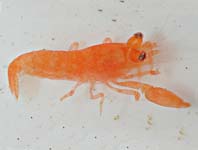Abstract
Reproductive timing, fecundity, and average egg sizes were examined for galatheoid and chirostyloid squat lobster collections from the Gulf of Mexico. While congeners did not always significantly differ in egg size or timing, each genus had a unique average egg diameter size which may indicate whether the developing embryos will be lecithotrophic or planktotrophic larvae. The eggs of Eumunididae, Galatheidae, and Munididae were more numerous and smaller than the larger and less abundant eggs of Chirostylidae and Munidopsidae. With the exception of members of the Munididae, members of genera within the same family had distinct egg diameters. Ovigerous females were significantly larger than non-ovigerous females in some species (i.e., Uroptychus nitidus, Munida forceps, Galacantha spinosa, Munidopsis abbreviata, M. alaminos, M., erinacea, M. robusta, M. sigsbei, and M. simplex). Munidopsis erinacea and Munida affinis males were significantly larger than females; the reverse was true for Munidopsis robusta and Munidopsis simplex. All other species studied did not have a significant difference between males and females. The spatial and bathymetric ranges for many species are extended in this study from prior reports. Seasonality of reproduction was evident in few species, but this may be a result of limited sample sizes.

